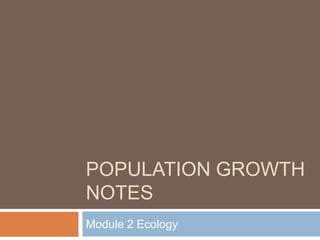
Module 2, Lesson 4 Ecology
- 1. Population Growth Notes Module 2 Ecology
- 2. Growing rapidly Tripled in size in about 70 years Est. size to day 6 billion+ (approx. 2 billion in 1930) Human Population
- 3. Problems cause by humans Thinning ozone layer – ozone layer protects living things from ultraviolet radiation form the sun Climatic changes Greenhouse effect: insulates earth from the deep freeze of space; keep Earth warm Caused extinction of other species – extinction rate higher today than at any other time Increased pop. requires increasing amts. of food, energy, space – greater share of Earth’s resources will be required Burning Fossil Fuels for energy – releases carbon dioxide; excess CO2 traps too much heat in Earth’s atmosphere
- 4. Human Population Growth Improved by agricultural development, hygiene, diet, and economic conditions improved Today, population growth is faster in less-developed countries and slower in more developed countries
- 5. Population Dynamics Changes in size and composition over time Measure include: birth rate - number of births over time (in US it is 4 million per year) death or mortality rate – number of deaths in a period of time (in US it is 2.4 million per year) life expectancy – how long an individual is expected to live (1996: in US it was 72 yrs. for a man and 79 for a woman)
- 6. Population Growth Rates Amount of change within a population’s size in a given time Four factors that affect growth rates: Birth Death Emigration – movement out of a population Immigrations – movement into a population Demographers – scientists who study populations dynamics Birth rate – death rate = growth rate
- 7. Carrying capacity of a population is the number if individuals the environment can support for an indefinite period of time. Populations fluctuate over time do to environmental changes. Small populations are less able to rebound from environmental changes. They are more likely to experience inbreeding and their genetic diversity is low.
- 8. Population Growth Curves Linear – growth occurs along a straight line NOT what we see w/ populations of organisms
- 9. Population Growth Curves Exponential – as population gets larger, it grows faster (population explosion) “J shaped”
- 10. Predator-Prey Predator-Prey – (predation is density dependent limiting factor) When population grows beyond carrying capacity of environment, density-dependent Limiting Factors reduce population population grows/shrinks cycles
- 11. Carrying Capacity What is seen in most populations of organisms. Population growth is limited by factors in the environment such as food supply or habitat.